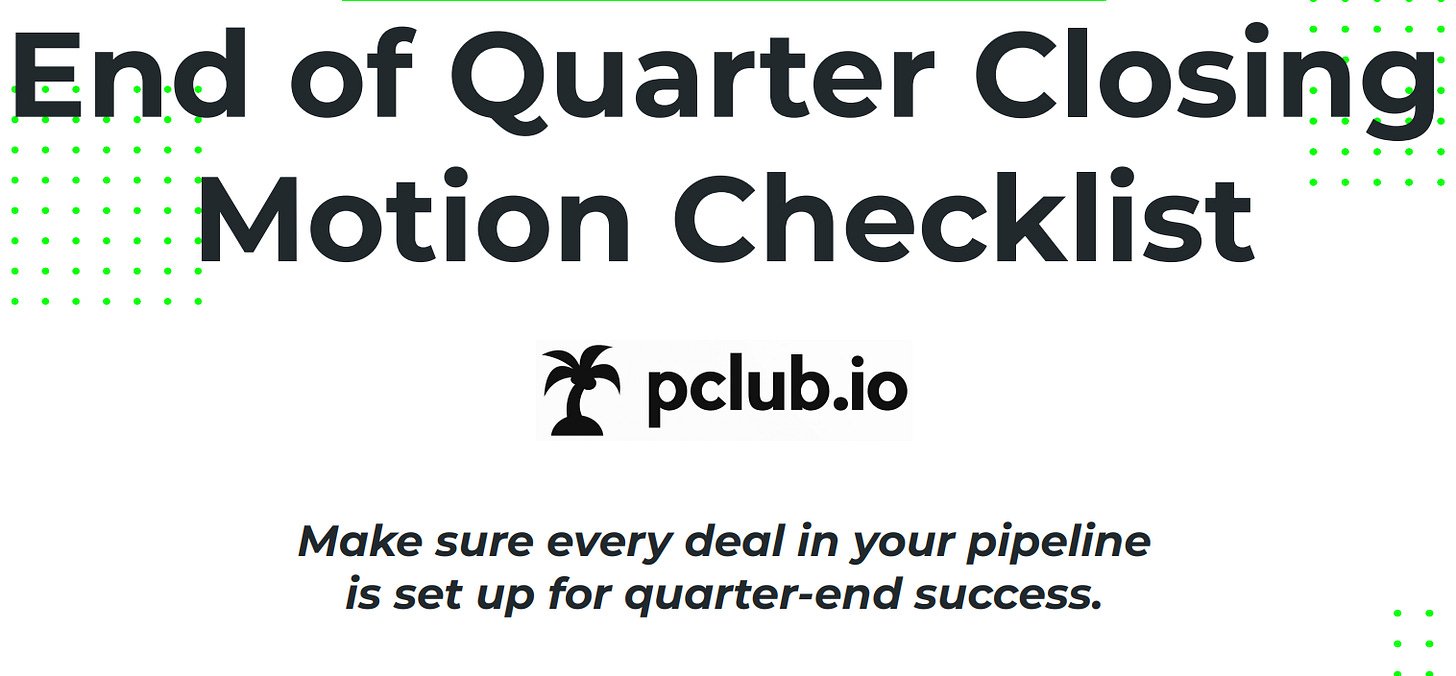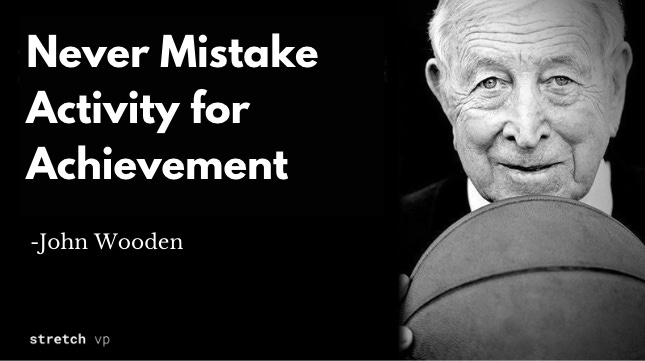Tactical Takeaways
Tactical takeaways to share with your team as you look to crush Q4 and plan for Q1

Hey there friends. We blinked and now we are staring at less than 30 business days to get those deals across the catwalk and finish line for 2022.
For those of us in leadership, Q4 also means strategy, training and planning for next year as well. It’s a full plate and we haven’t even got to Thanksgiving yet.
In this week’s edition of Stretch Weekly -
Chris Orlob gifts us his insightful End of Quarter checklist to help us in our quest to close out the year strong.
People.ai gives us eight strategies that can help you stand out from the pack as you double check and re-align strategies for the new year.
Plus - don’t miss snippets this week from those that do - with tactical takeaways to share with your team as you look to crush Q4 and plan for Q1.
THANKS for reading!!
-Grant
And lastly - as always, if you find this newsletter valuable- subscribe or share it with someone who might as well 👊.
STRETCH SHARES
Closing Motion Checklist
If you’re not following Chris Orlob, go ahead and fix that today. He’s constantly publishing real life case studies, successes and stumblings for us to learn from. He recently posted this insightful checklist to help us in our quest to close out the year strong. Pull this checklist up in your next deal reviews to see where gaps may be.
People:
Economic buyer: Who has the authority to release the funds for this deal? How confident are you that you have them covered?
Saboteur: Is there anyone that would stand to gain something from this deal not happening? Do you have a mitigation plan?
Signer: Who actually signs the contract? What’s their status? How many people have to “click the approval button” in the path to signature?
Uncovered influencers: Is there anyone we haven’t talked to or gotten buy-in from that will influence this?
Buying Process:
Security review: Do they need to do one? How long does it take? Have you started?
Legal review: Do they need to do one? How long does it take? What’s required?
Budget: How do they plan on funding? Do they have budget locked down, or do they need to find it?
Procurement: How is finance and procurement involved in these final stages?
Timeline: What’s the estimated timeline to signature based on what they know? What’s driving their timeline? Reconfirm every call leading up to quarter end.
Remaining path to signature: Assuming the above items are squared-away, what’s the remaining path to signature?
Closing motion
Risk: Ask what would derail us from here, even with all of the above squared away.
Calendar backtop: Once contract is out, schedule a calendar backtop with your champion 2-3 days out “just in case we hit any snags”
Daily reminder: Send Docusign reminder every morning. Ask a simple “yes/no” Question: “did you receive it?”
Lean on your champion: Ask them to help get the deal through.
Follow up daily. Send a “friendly ping” email. Reply to original thread. Call to after.
8 Sales Strategies To Reach & Convert More Customers
As we look to re-align sales strategies for the new year, People.ai gives us eight strategies that can help you stand out from the pack.
1. Define Your Ideal Buyer Profile
Create (a.k.a. buyer personas) that describe your targeted market segments. This should include notes on their buying process, market size, and psychographics. It should connect to your product offering and how it can address pain points.
2. Separate Yourself With A Nexus
A nexus is defined as a connection between two or more things. In successful sales strategies, a nexus is an insight that will change the way your customer sees a problem and thinks about it. This insight is usually polarizing, but this is fine as long as the majority of your target market agrees with it and the solution you offer.
The best nexus for your organization is polarizing, challenges your customer’s confidence, and makes them question the way they think. Persuade them that the status quo needs to change.
3. Sell The Micro-Problem
“Sell the Problem, Then the Solution” is a popular sales strategy to reach more customers. However, we often fail to think of how a product offering offers a distinct solution. There are a number of ways to solve a problem, but typically your product can only do a few of them.
Go back and think about the problem that your unique selling point solves. This will help your sales reps distinguish your product and emphasize its value.
4. Decrease Your Time-To-Value
We often say “time is money”, and there’s nothing that a prospective customer hates more than feeling like you’re wasting their time. When making sales calls, your solution selling should get to the point fast. Emphasize the value immediately.
This is especially true for cold calls. You are more likely to build new customer relationships if you open the call by immediately saying why you’re calling. Make it a point to shorten cold emailing and calls with all prospective and existing buyers.
5. Build A Tailored Marketing Automation Program Around Your MQLs
Marketing qualified leads (MQLs) are those that your marketing team has measured to be more likely potential customers. However, generating them takes a lot of time and hard work. To optimize team performance, you should use a marketing automation program to get better leads.
Different programs have different ways of doing this. Try a few and see which best works with your company’s sales process. Some score leads to see if they fit your ideal customer profile before your sales reps reach out. Others track customers’ browsing behavior to get feedback on what content matters most to them.
6. Capture The Problem Better Than Your Competitors Do
The key to customer acquisition is to show them that you understand their problem better than the competition. Stop harping on product functionality and the superior features, and start training your sales organization to learn about your potential customers’ problems.
Put them in the buyer’s shoes and encourage them to think about what makes them tick. By knowing their pain points, you can effectively show how your organization and product can successfully solve these.
7. Find A Weakness Within Your Competitors’ Strength
Let’s face it, no organization or product can do everything. Take an honest look at your competitors and what they’re best at. Then think about what that strength fails to solve for your ideal customers.
For example, Apple may not have Microsoft’s broad customizability. However, it’s instead positioned itself as an easy-to-learn, one-size-fits-all tech and device provider. This allowed it to capture a large customer base that wasn’t into tinkering with systems and programs.
It’s okay to acknowledge your opponent’s strengths, and some customers may actually appreciate this as a sign of honesty. This even builds trust in your organization. The key is to figure out how your own organization can do something better than your competition.
8. Train Your Team To Be Just 1% Better
Weak links can hurt the entire organization, but there’s also no way that everyone can be good at everything. Instead of forcing each sales employee to optimize their performance for every role, examine their strong points and jobs in your organization.
STRETCH SNIPPETS
Sahil Mansuri pens a good post on getting personal. Your standard "here's how we can help you save $$ and time" email is NOT going to work. You have to actually do the work. Create value. Be smart.
Griffin Reilly had a great post about the #1 reason sales reps can’t cut through the noise - referring to what he calls “The Seller Deficit Disorder”, and how its the top reason prospects don’t want to work with you. 1) You don’t understand their business and 2) you don’t listen.
You just met a prospect at a conference. "Send me an email next week, I'll introduce you to our team." Only to never hear from them again. Vin Matano shares his simple 2-step (email, then InMail) cadence for conference folow-ups.
80% of prospects say “no” four times before they say “yes”, yet 40% of salespeople give up after the first “no.” Follow up is crucial when it comes to sales. MixMax gives us 25 follow up email subject line examples that can increase email open and response rates + lots more data-backed insight. Definitely got to share this one with your team!!
Sarah Brazier shares her “Zoom Brady Bunch View” hack for better discovery during demos. This is the way!!!
🧠 Mindset
Thanks for reading!
My hope is if you find this valuable, consider sharing it with friends (or signing up if you haven’t already).
— Grant 👋
About stretch vp: confessions, learnings, and insights from sales leaders in SaaS
Compiled and aggregated from a network of sales leaders in SaaS, Stretch VP showcases learnings, insights, and experiences as well as best practices to overcome common hurdles, obstacles, and setbacks in your quest for excellence as a sales leader in SaaS.
Are you a VP, Director, thought leader, or content producer in the SaaS space? We’d love to have you contribute. Just reply to this email and I’ll be in touch.
Also… check out the blog or follow on Twitter





